Articles in the Workshop Category
Featured, Guitar 101, Workshop »
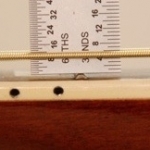
What the hell is a neck reset and why the hell would you want one?
You’ll often hear talk about neck resets (or sometimes, neck sets) but the reasons it’s required are often glossed over by saying it’s just something that acoustics need sometimes. It’s all pretty simple and it has to do with geometry (stay with me…) and wood.
Huh?
Let me try to make a little sense of that.
Why would I need a neck reset?
When an acoustic guitar is made, it is designed and constructed such that the guitar’s string height …
Featured, How To, Workshop »
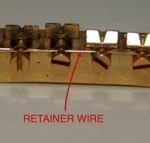
Buzz is the bane of the guitarist. Fret-buzz is the one that gets all the press and, to be sure, it’s a serious pain. Frets are not the only thing that is likely to buzz, rattle and hum on your guitar though. If you’ve got a Gibson (or Gibsonesque – the one below is a Gretsch) guitar it’s possible that your Tune-O-Matic bridge may be the cause of that buzz you hear.
If you can hear a metallic rattle or buzz when you pick a note – sometimes all notes, sometimes …
Featured, Workshop »
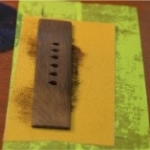
The third and last article in the story of the restoration of a pre-’34 Martin guitar with a broken bridge. The first two parts of the Martin Custom Bridge Replacement cover removal of the broken bridge and the carving of a replacement.
The first step in getting this replacement back on the guitar is ‘fitting’ it to the guitar top. Like many of us, over the years, pretty much all guitars gain a bigger belly. Under a lot of tension from the strings, changes occur in the wood of a guitar. …
Featured, Workshop »

This is second part of the story of replacing a broken bridge on a, rather lovely, pre-1934 Martin. This update is slightly tardy so feel free to catch up on part one (where we remove the broken bridge) first.
Done? All caught up? Splendid.
Now the broken bridge is off, this is how it all starts. You can see the removed bridge sitting on a block on Brazilian rosewood that will become its replacement. Brazilian rosewood is in extremely short supply and is very tightly controlled species as it was over-harvested for …
Featured, Workshop »
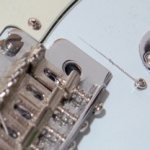
Gah! Broken strings. Who needs ’em?
I remember learning to play guitar as a poor teenager and seeking out music stores who sold single strings as I couldn’t afford to replace a whole set. I remember winding extra turns unto my tuners and, when a string broke, carefully tying its ball-end onto the slack in the string so I could avoid having to buy even another single string.
While all of that may have been character-forming, it wasn’t much fun. If only I’d known then about a relatively simple method of reducing the …
Workshop »
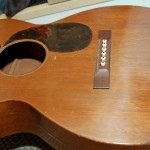
This is a bit special. It’s a lovely, pre-war Martin. Actually, it’s pre-1934 if you want to get a little more precise (but only a little) – it’s fitted with bar frets.
It’s been through the wars a little and has, at some stage in the past had a long side-crack repaired. That repair has lasted some time from the look of it and doesn’t overly concern me.
What is a concern, however, is the bridge. The leading edge has cracked and broken off under string-tension. The owner saved the piece that …
Headline, How To, Workshop »
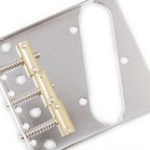
The 3-Saddle Intonation Problem
If you play a Telecaster with a 3-saddle bridge (like the one shown opposite), you may be aware that setting intonation on the instrument is a matter of compromise. Because a single adjustment screw sets the intonation on two different strings at the same time, Telecaster intonation is really a matter of ‘balancing the differences’ and getting each string as close as possible without putting its partner string out by too much.
Move to a 6-saddle bridge
If this really bothers you, you can move to a 6-saddle bridge. …
How To, Workshop »
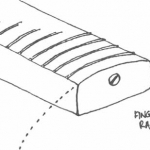
You’re a millionaire playboy guitarist with a vintage Fender or you’re just someone with one of many current or past Fender originals and reissues.
Whatever the case, you’re finding that those big blues bends that you love doing are buzzing or, worse still, choking-out completely and dying. Your guitar plays fine and buzz-free the rest of the time but as soon as you go for a nice, soulful, bent note, it buzzes or chokes.
Annoying.
Possibly more annoying is when I tell you that there’s a good chance it’s just a limitation …
Workshop »
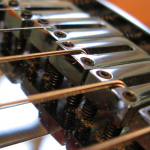
There are a number of reasons that a plucked guitar string might buzz. We’ll probably go into some of those reasons in future articles but, as I happened to have one of the more uncommon reasons for a buzzing string in the workshop, I thought I’d share it with you.
What I had was a Tele with a few minor issues and a pronounced, ‘zingy’, buzz on the D-string. This wasn’t fret-buzz – the string buzzed even when fingered at the last fret with no more neck in the picture (and …

